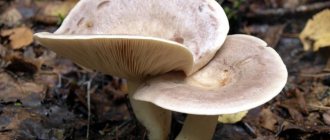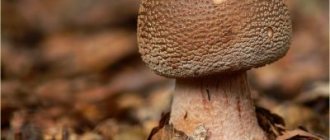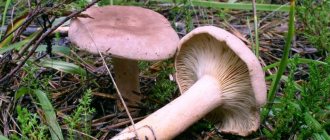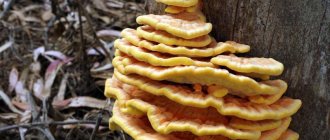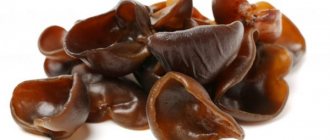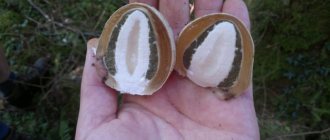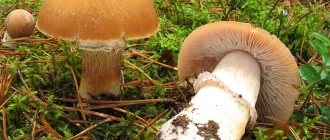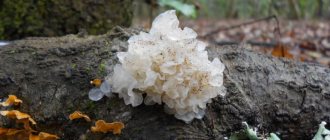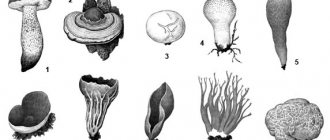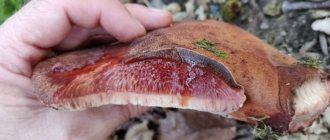Milky fungi (Lactarius) are a separate genus of lamellar fungi, numbering a very large number of species. The most famous of them are milk mushrooms, saffron milk caps, and volushki. Their name comes from the Latin word, which means “milk” or “milk-giving.” All these mushrooms belong to the Russula family. As a rule, in Europe, most species of these mushrooms are considered inedible, and some are even poisonous. While in Russia many are consumed as food after undergoing additional processing, such as salting or pickling. Such mushrooms are called conditionally edible. The mushroom about which the story will go is exactly one of them - the common milkweed.
Description of the mushroom
A representative of the Mlechnikov family, the Syroezhkov family. The species was given the Latin name Lactarius helvus in 1838 by the Swedish botanist and mycologist Elias Magnus Fries.
The gray-pink milkweed is often called the gray-pink or inedible milk mushroom, as well as the common milkweed, roan or amber milkweed. The mushroom is considered inedible, but is not classified as poisonous.
The cap of young specimens is flat, later it becomes funnel-shaped, reaching 12 cm in diameter. The edge looks turned down, with a tubercle in the center. The skin color is brown with a pink tint, sometimes grayish. In dry weather, a silky shine appears.
The hymenophore (the lower part of the cap) has the shape of plates, rather weakly attached to the stalk and descending along it. The color is often whitish and changes to fawn or pink with age. The spores are creamy ocher in color, round, reticulate.
The pulp is often light yellow, fawn, emits a strong unpleasant odor, very spicy, similar to chicory, and has a bitter taste. The color does not change when cut. The milky juice is scanty, watery, whitish in color, and tastes slightly pungent. The milkweed does not change color when in contact with air.
The stem has the shape of a cylinder, reaches 9 cm in height, and up to 2 cm in diameter. Young mushrooms have a loose stem, the same shade as the cap; in old ones it becomes hollow. Closer to the hymenophore, the color is somewhat lighter, mealy, and whitish fibers can be seen below.
Time and place of fruiting
Fruiting time is from July to September, most often found in the temperate zone closer to the north. Mycorrhiza forms with spruce and pine, sometimes with birch. Loves damp places, acidic soils. Most often it can be found in forests among mosses, in blueberry fields, and also on the outskirts of sphagnum bogs. Remains dry even during rainy periods and grows in large groups.
How to distinguish a satanic mushroom
What does a satanic mushroom look like? To detect a “partisan” in a mushroom basket, you need to know well what he looks like. It has distinctive features:
- The young mushroom has a cap that looks like a pillow, on which there are rounded bulges.
- The old model has a flatter cap, it can reach 30-40 cm.
- In the shade, the cap can be dirty gray or olive-gray, in the light it is brown, like a boletus.
- If it's dry outside, the surface will be smooth and dry. If it's wet, it's mucous.
- Tubular layer with small pores, dense.
- The tubes can be yellow and yellow-olive, the pores are red. When pressed they turn blue.
- The leg is the same as that of the boletus, with a massive base and tapering towards the cap. The main difference is its color. It is yellow-red under the cap, the middle can be brick-red or dark red, the base is brown. A mesh pattern is visible. If you cut it, a blue tint will immediately appear, and then red.
But the leg of the satanic mushroom does not always have such a bright color; it can be gray-brown, like the cap. The red tint is clearly visible at the pores around the stem. There are no pronounced red or blue flowers on the cut; the light flesh slowly acquires a cloudy brown tint.
There is another important difference between the satanic mushroom - the smell. It is especially characteristic of older specimens
It smells like rotten onions, carrion and sour food. Young representatives of this species may have a slight mushroom odor. Therefore, if you encounter an adult and smelly specimen, you should remember what it looks like. The same beautiful young mushroom can then also be identified.
False counterparts of the Amber Milky Way
The smell of this mushroom will not allow it to be confused with any other “relative” or double. It is so harsh and unpleasant that many people avoid it and don’t even try to put it in the basket.
| Name | Smell and taste | Appearance of the mushroom | Edibility |
| Milk mushroom inedible |
In Russia, gray-pink milkweed is considered conditionally edible, but special processing (soaking) must be carried out before cooking.
How to distinguish from saffron milk caps?
Inexperienced mushroom pickers may confuse gray-pink milkweed with saffron milk cap, but in order to correctly identify the species, you should first smell the specimen you find, after which all doubts will disappear. The main difference: saffron milk caps have a brighter cap; when secreted, the milky juice changes color and forms spots on the surface. In addition, the juice itself is bright and orange. The cap of the saffron milk cap acquires a greenish tint with age.
Growing at home and in the country
Oak milkweed is quite widespread in the natural environment, so the advisability of growing it at home is in doubt. First of all, it is a commercial mushroom.
However, if desired, you can grow the milkweed yourself from ready-made mycelium. For a summer residence, the most preferable option is when the mycelium is planted together with a mycorrhizal tree seedling. In this case - oak, alder, beech, etc. The mycelium is sprinkled on the hole prepared for the seedling, and the plant itself is planted there. Planting takes place from May to September.
It is also possible to grow oak milkweed in a cool, dark room, such as a basement. Sawdust of deciduous plants serves as an excellent substrate, that is, a nutrient medium for the germination of mycelium. They must be disinfected in advance by treating them with hot steam or boiling them for an hour. Fill plastic bags with the prepared substrate, tie them tightly at the base, and make slits on the sides at a distance of 7-15 cm from each other. Pieces of mycelium are placed in the slots, lightly compacted into the substrate. For the proper development of the mycelium, it is necessary to maintain an optimal indoor microclimate. Before the fruiting bodies appear, the recommended temperature is about 20 degrees, then it can be reduced to 15 degrees.
Cooking information
It is recommended to collect only young specimens whose cap has not yet taken on a cone shape. It is not recommended to dry these milkweeds; the unpleasant smell will only become stronger, and therefore they are often salted and pickled.
You should first soak them for 1-2 days, periodically changing the water. Then boil for 30 minutes, drain the broth. If the smell remains, you can simmer for another 20 minutes.
For pickling, after all the preparations, the mushrooms are placed in a prepared container, with dill laid on the bottom, and each layer of mushrooms is sprinkled with salt. Then you can optionally put:
- finely chopped garlic;
- dill;
- laurel;
- cloves;
- allspice.
There are cooks who use only mushrooms and salt for pickling. The amount of additional ingredients can be adjusted according to your taste. After that:
- Cover the milkweed with clean gauze folded in several layers.
- Press everything down with a wide plate.
- Place a heavy weight on top.
Important! After a week, the mushrooms will be covered with brine. If this does not happen, you should increase the weight of the load or add highly salted water.
In addition, the gauze should be washed from time to time to prevent the fruits from souring.
After 40 days, the salted milkweeds are ready, you can put them in jars and put them in the refrigerator. Grey-pink breast milk is also good when marinated. Pre-treatment is no different, but the last boiling should be done in salted water. Then the marinade is prepared, for 1 liter of water you will need:
- 1 tbsp. l. salt and sugar;
- 70 ml vinegar;
- 2 laurel leaves;
- 3 cloves;
- 3 cloves of garlic;
- 5 peas of allspice;
- dill umbrella;
- 1 tsp. mustard seeds;
- table horseradish leaf.
All components are combined with water and brought to a boil, then do the following:
- Place the mushrooms into the pan and continue cooking for another 30 minutes.
- Afterwards, you need to transfer the fruits into prepared jars and fill them with marinade.
- If you need to keep it for a long time, then sterilization will follow for half an hour, then roll it up and put it away to cool in a blanket.
If you eat it right away, just cool it and put it in the refrigerator.
Collection and storage
It is good to pick mushrooms in dry weather, since if collected in rain or damp conditions, they can spoil faster. It is best to do this in the morning, when their aroma is stronger and their structure is stronger.
Mushroom pickers must comply with several conditions:
- collect only known types of mushrooms;
- use wicker baskets in which the mushrooms are well ventilated and remain fresh longer;
- lay with their caps down, and long-legged ones sideways.
- When collecting, twist or swing, then they are easier to separate.
It must be remembered that cutting mushrooms with a knife is not recommended, otherwise this may lead to rotting of the entire mycelium.
Best materials of the month
- Coronaviruses: SARS-CoV-2 (COVID-19)
- Antibiotics for the prevention and treatment of COVID-19: how effective are they?
- The most common "office" diseases
- Does vodka kill coronavirus?
- How to stay alive on our roads?
Fresh mushrooms are a perishable product. They need to be stored in a cool, ventilated area, or in the fresh air under a canopy. Usually they are scattered in a thin layer on a specially prepared surface: on tables, clean flooring, tarpaulin. They should not be piled up, kept in barrels, or exposed to direct sunlight or high humidity. The shelf life of milkweeds before pre-treatment should not exceed four hours.
Gray-pink milkweed (Lactarius helvus)
Breast gray-pink
Milk mushroom inedible
Common milkweed
Milky roan
Milky amber
Gray-pink milkweed (lat. Lactarius helvus ) is a mushroom of the genus Milky (lat. Lactarius) of the Russulaceae family (lat. Russulaceae). Conditionally edible.
Cap of the gray-pink milkweed: Large (8-15 cm in diameter), more or less round, equally prone to the formation of a central tubercle and a depression; With age, these two signs can appear simultaneously - a funnel with a neat lump in the middle. The edges are neatly tucked in when young, and gradually roll out as they mature. Color - difficult to describe, dull grayish-brownish pink; the surface is dry, velvety, not prone to hygrophany, and does not contain any concentric rings. The pulp is thick, brittle, whitish, with a very strong spicy smell and a bitterish, not particularly pungent taste. The milky sap is scanty, watery, and may be completely absent in adult specimens.
Plates: Weakly descending, medium frequency, the same scale as the cap, but somewhat lighter.
Spore powder: Yellowish.
The leg of the gray-pink milkweed: Quite thick and short, 5-8 cm in height (in mosses, however, it can be much longer), 1-2 cm in thickness, smooth, gray-pinkish, lighter than the cap, solid, strong in youth , as it matures, forms uneven gaps.
Distribution: Gray-pink milky is found in swamps among birch and pine trees, in mosses, from early August to mid-October; in late August and early September it can, under favorable circumstances, bear fruit in huge quantities.
Similar species: The smell (spicy, not very pleasant, at least not for everyone - I don’t like it) allows you to distinguish the gray-pink lacticaria from other similar mushrooms with complete confidence. For those who are just starting to get acquainted with laticifers, relying on the literature, let’s say that another relatively similar mushroom with a strong-smelling pulp, the oak milky Lactarius quietus, grows in dry places under oak trees, is much smaller and generally not at all similar.
Edibility: In foreign literature it goes through the list of mildly poisonous; we refer to it as inedible or as edible, but of little value. People say that if you are willing to put up with the smell, then it turns out to be milky. When it appears in the absence of valuable commercial mushrooms, it is at least interesting.
Notes It's always awkward for a mushroom enthusiast to admit such things, but Lactarius helvus was one of the few milkweeds that made a distinctly inedible impression on me. A large, weighty mushroom with an unpleasantly dry cap, unaffected by either a worm or a slug, for some reason does not fit into the basket. Perhaps it's a suspicious smell; if it had been even a little weaker, it could have been called piquant, spicy, or just like a chemical weapon. Like many other ordinary mushrooms growing in pine trees, I became acquainted with the gray-pink milkweed very late, at a conscious mushroom age; met and broke off the acquaintance on the first pretext that came up. Something is wrong here. Something the same as that of the oak milkweed. It seems to be a mushroom of a noble family and a brave figure, but it doesn’t make you happy. Or the problem is no longer even in the mushroom...
| Bitter taste with a strong chicory odor | The cap is pinkish with a brown tint; in dry weather it has a silky sheen. | Inedible or conditionally edible | |
| Milky zoneless | Odorless with spicy taste | Has a sandy color, often brownish | Edible |
| Milky zonal | Fruity pleasant smell with a burning taste | Bright yellow or orange cap, covered with mucus when it rains | Conditionally edible |
| Gorkushka | Has the smell of spruce needles | Hat dark beige, brown, small size | Conditionally edible, medicinal |
| Group: | Lamellar |
| Records: | White, beige-gray-pink |
| Color: | Beige-gray-pink |
| Info: | When broken it smells like chicory |
| Department: | Basidiomycota (Basidiomycetes) |
| Sub-department: | Agaricomycotina (Agaricomycetes) |
| Class: | Agaricomycetes (Agaricomycetes) |
| Subclass: | Incertae sedis (uncertain position) |
| Order: | Russulales |
| Family: | Russulaceae (Russulaceae) |
| Genus: | Lactarius (Millary) |
| View: | Lactarius helvus (Grey-pink milky plant) |
This type of milkweed is inedible according to some sources, but conditionally edible according to others. In foreign literature it is noted as slightly poisonous; in the domestic literature - as inedible or as edible, but of little value due to the strong unpleasant odor.
Stereum purple: photo and description
| Name: | Stereum purple |
| Latin name: | Chondrostereum purpureum |
| Type: | Inedible |
| Synonyms: | Hondorostereum purple, Stereum purple-violet |
| Characteristics: |
|
| Taxonomy: |
|
Stereum purpurea is an inedible species of the Cyphella family. The fungus grows as a saprotroph on stumps and dry wood, and as a parasite on deciduous and fruit trees. It often settles on the walls of wooden buildings, leading to rapid rotting and destruction. To recognize a mushroom, you need to study its description and look at the photo.
Where does stereoum purple grow?
The variety begins to bear fruit from September to mid-December. It can be seen on dry wood, stumps, as well as living trunks and roots of deciduous trees. It grows in numerous groups, less often in single specimens. When garden crops are infected, it causes white rot and milky sheen disease. The disease can be recognized by discolored foliage, which over time becomes shiny with a pronounced silvery tint. Without treatment, after 2 years the branches of the affected tree shed their leaves and dry out.
What does stereo magenta look like?
Stereum purpurea is a parasitic species with a small disc-shaped fruiting body, about 2-3 cm in size. Felt-hairy, cream or light brown variety grows on wood in the form of small spots when young. With age, the fruiting body grows and becomes fan-shaped with wavy, slightly drooping edges.
After frost, the fruit body fades and becomes grayish-brown in color with light edges. Because of this color, the parasitic fungus is difficult to recognize, since in appearance it is similar to other types of stereoums.
The smooth, slightly wrinkled hymenophore is dark purple in color with a light whitish-purple border. It reproduces by colorless, cylindrical spores that are located in coffee spore powder.
The pulp is thin and tough, with a pleasant spicy aroma. In a section, the upper layer is colored gray-brown, the lower layer is pale cream.
Is it possible to eat Stereum Magenta?
Stereum purpurea is an inedible mushroom. Due to the lack of taste, dense, hard pulp and nutritional value, the variety is not used in cooking.
Similar species
This variety has similar counterparts. These include:
- Trihaptum fir. The mushroom grows on dry coniferous wood in multi-layered tiers. The small fruiting body is light brown. The surface is felt, pubescent, after rains it becomes covered with algae and acquires a greenish tint. The underside is bright purple, becoming chocolate-colored and elongated with age.
- It is coarse-haired, grows on stumps and dead wood, rarely attacks living weakened deciduous trees. The species is perennial, has a fan-shaped fruiting body with unfolded edges. The surface is smooth, painted lemon-brown with a greenish tint. Prefers to grow in groups, forming long, wrinkled ribbons. Due to the lack of taste, the species is not used in cooking.
- Felt, distinguished by its larger size, velvety surface and reddish-brown color. Grows on stumps, dead wood, on sick, diseased trees. The species is inedible because it has hard flesh.
Application
Since this variety attacks dry wood and causes a fungal disease on apple trees, pears and other stone fruits, both gardeners and workers at wood processing plants fight against it. And due to the lack of taste and hard pulp, it has no nutritional value and is not used for cooking.
Conclusion
Stereum purpurea is an inedible member of the Cyphella family. The fungus often attacks dead wood, treated wood, live fruit trees and the walls of wooden houses. If timely control is not started, the fungus can quickly destroy buildings and reduce the yield of stone fruit trees.
Description
This mushroom is somewhat similar in structure to bittersweet, but differs from it in its lighter color.
hat
Grows to medium size (about 15 cm in diameter). In the middle of it, both a depression and a tuberculate outgrowth can form. As the fungus grows, both signs appear simultaneously.
The edges of the cap of young mushrooms are folded downwards, and with age they open up. Its color is beige-gray-pink. The surface is not slimy, dry and velvety to the touch.
Pulp
Fleshy, pale and rather fragile. When broken or cut, the pulp smells very strongly of chicory. It tastes bitter. It produces a small amount of milky juice, the consistency of which resembles water. The juice does not change color in air.
Leg
The legs of these milkweeds are short and very stocky (about 8*2). Their color is slightly lighter than the surface of the cap. In young specimens, the legs are full, and during the process of growth they form uneven cavities inside. These lactifers do not have any additional growths on their legs; they are smooth.
Spore-bearing layer
The spore layer is made of plates. Plates of medium thickness and frequency of arrangement. The color is almost the same as the cap, but a little lighter. In very young mushrooms, the plates are almost white, then darken.
Spore powder
The spores of the gray-pink lacticifer are almost round, of medium size, with a mesh surface, the bulk of the powder is orangish-yellow.
False flywheels
Parasitic moss fly
Non-toxic, bitter, unpleasant in taste, grows on the remains of the false puffball. The cap is up to 5 cm in diameter and does not turn blue when damaged.
Chestnut mushroom
Brown-red, convex, up to 8 cm in diameter, does not change color when cut. Cylinder leg 3.5 x 3 cm to match the cap. This mushroom is edible, but only after boiling and drying. Then the bitterness disappears.
Bile mushroom
The massive stem resembles the stem of a porcini mushroom. The diameter of the spongy cap is up to 7 cm. The reddish flesh tastes bitter and burns the tongue. Arthropods do not eat or lay larvae in this mushroom.
Pepper mushroom
The cap is light brown, convex, up to 7 cm in diameter. The flesh is loose, yellow, reddish when cut, and tastes hot and peppery. The leg is bent, cylindrical, the color matches the cap, yellower near the ground.
Similar species
This type of milkweed has practically no counterparts due to its extremely specific smell.
But outwardly it may look like:
It features a subtle concentric pattern on the cap. In addition, the smell is different - oak milkweed smells like hay, not chicory. In general, this mushroom is smaller and grows mainly near oak trees.
This mushroom is also distinguished by its more modest size and darker color, predominantly brownish-red. Doesn't smell like chicory like the gray-pink variety.
Ingredients
Various species of laticifers;
Coarse table salt - 50-60 g per 1 kg of boiled mushrooms. Garlic - 1-2 cloves per 1 kg of boiled mushrooms. Greens (or umbrellas) of dill, leaves of black currant, horseradish, oak. Details about mushrooms:
Any milkweed can be salted, since there are no poisonous species among them, and after salting, they are all quite edible. For pickling, we prefer to use small, young mushrooms with a tightly wrapped edge (photo 1).
The best in terms of taste: yellow milk mushrooms (Lactarius scrobiculatus), black milk mushrooms (Lactarius turpis) and white milk mushrooms (white milk mushrooms Russula delica) (white milk mushrooms are not laticifers, of course, but they are also very good when salted). Slightly worse than solyushka (Lactarius trivialis), milkweed (Lactarius torminosus and Lactarius pubescens), hollow milkweed (Lactarius rufus), and pepper milkmilk (Lactarius piperatus).
Third group: brown milkweed (Lactarius lignyotus), papillary milkweed (Lactarius mammosus), violin milkweed (Lactarius vellereus), silver milkweed (Lactarius flexuosus), camphor milkweed (Lactarius camphoratus), gray-pink (Lactarius helvus), faded milkweed (Lactarius vietus), brownish (Lactarius fuliginosus), lilac (Lactarius uvidus) and other small species.
In our area, worm-free mushrooms are practically never found (if you come across them, we salt them separately in a cold way), and there are no white milk mushrooms at all. The bulk of pickling mushrooms: nigella, volnushka, solyushka, duplyanka. Mushrooms from the third group make up no more than 25% of the total mass: we take them if there are no other mushrooms or only very beautiful young specimens. Camphor milkweeds retain their specific “aroma” when salted, so if you don’t like their smell, then it’s better not to take them.
Edibility
This species of milkweed is not usually collected or eaten. But in the absence of more edible mushrooms, it can be considered as an option for collection. Like all conditionally edible milkweeds, it requires long-term soaking or boiling, after which it can easily be salted. When salted it has a sour taste.
In some countries (for example, in Finland) this mushroom is fried in a fire. When fried, it has a bitter-spicy aftertaste. However, its smell is so pronounced that few dare to collect it.
Distribution and fruiting period of laticifers
The first lacticifers appear in the second ten days of July, and the last such mushrooms can be collected in the last ten days of September. But these mushrooms begin to grow actively in rainy, cool weather.
Milkweeds prefer damp places; they usually grow in lowlands in coniferous, mixed or deciduous forests; they are usually collected either under coniferous trees or birch trees. They usually hide in tall grass or among moss. Insects usually do not eat the caps of these mushrooms. Also found along the banks of swamps or ponds. They usually do not grow in hot climates; they prefer temperate latitudes. Therefore, the places where laticifers grow are forests in European countries, the middle and central regions of our country, in Western Siberia, the Urals, and also in the Far East.
Interesting Facts
Milkies have a number of interesting features:
- In many foreign countries these mushrooms are not eaten.
- In Russia, milk mushrooms (or milk mushrooms) are traditionally valued as pickling mushrooms.
- There is more protein in these mushrooms than in meat.
- With a high protein content, milkweed contains few calories, which is why it is a dietary product.
Consumption of milkweed lowers blood pressure and prevents the development of atherosclerosis. The gray-pink milk mushroom is not the most tasty and edible option among milk mushrooms. Therefore, it is quite rarely collected in the presence of other valuable mushrooms. However, in the absence of other options, it can be used for pickles.
It is important to prepare it correctly by soaking or heat treatment, otherwise the mushroom will be bitter and smell unpleasant. People with allergies and patients with ulcers, gastritis and gastroduodenitis should not eat mushrooms, since mushrooms are rich in chitin and are therefore poorly digestible.
Mushrooms should not be given to children, since their stomachs are not yet ready to digest such heavy food.
If you see a gray-pink milkweed for the first time, it may seem that there is a fruiting body in front of your eyes, similar to a milk mushroom and a milkweed. In common parlance, people call this mushroom a hybrid. If we follow the data obtained from foreign sources, then this variety is classified as slightly poisonous. It is not very valued among our compatriots, because there is no reliable data regarding edibility. But certain categories of people soak for a long time, boil, then salt the specimens and consume them as food.
Several recipes for preparing milkweed mushrooms
- Number of servings: 6
- Preparation time: 24 minutes
- Cooking time: 1 minute
How to cook salted milk mushrooms
This genus includes the well-known clams, saffron milk caps, milk mushrooms and more than 400 species, most of which are considered poisonous. All milkweeds found in Russia are used for food, most often salted or pickled. What all these species have in common is the ability to secrete a slightly bitter milky juice when damaged.
When salted, they turn out dense, tasty and have a pleasant crunch. They can be cooked hot or cold. Any species is suitable for pickling, but milk mushrooms and duplyanka are especially good for the first method, and saffron milk caps and trumpets for the second. To get a delicious snack, follow a few simple steps:
- Clean the mushrooms from debris, as the stem retains bitterness during cooking, cut it off. Soak the mushrooms in a large saucepan, press down on top, completely submerging with water.
- Soak the milkweeds for a day, draining the water twice and refilling with clean water. During this time, the color of the solyushki will turn yellow, the nigella will turn burgundy, and the plates of the pepper milk mushrooms will turn green.
- Boil the mushrooms in unsalted water. After 15 min. Once boiling, remove from heat and cool.
- For pickling, take an enamel pan or bucket, wash and scald with boiling water. Lay out dill with currant leaves and mushrooms in layers, placing their caps up, sprinkle each with salt, periodically add garlic, cut in half. Place a flat plate or lid on top and place a weight.
Place the pan in a cool place, taste the mushrooms after a week, add salt if necessary. After a month, the mushrooms will be salted. They can be put into jars and stored in the refrigerator.
Recipe for fried milk mushrooms
They make a tasty and satisfying second course. It will require the following ingredients:
- mushrooms – 0.5 kg;
- sour cream 2 tbsp. l.;
- butter – 50 g;
- onion – 1 piece;
- bay leaf – 3 pcs.;
- garlic – 1 clove;
- salt to taste.
It is best to use saffron milk caps or volnushki; other types may be a little bitter. To get rid of the unpleasant aftertaste, cook milkweed as follows:
- Peel the mushrooms, remove the stem, cut into pieces. Soak them for 5 hours, rinsing and changing the water.
- Boil for 15 minutes. in unsalted water, add bay leaf for flavor. Cool, rinse.
- Fry the chopped onion until golden brown, add the mushrooms to the pan, and after 10 minutes. sour cream, salt and spices, simmer for another 7 minutes.
Serve mushrooms with boiled or fried potatoes. Prepare immediately before serving, as the dish cannot be stored for more than a day.
The milkweed contains microelements that are beneficial for the body. It can be used to prepare various dishes, but it tastes best when salted.
Description
- The gray-pink lacticaria is a plastic mushroom that belongs to the russula family and the genus of lacticaria. Otherwise, these specimens are called gray-pink inedible milk mushroom, as well as amber or roan milk mushroom.
- As for the description, the top is round in format, but can be flattened or convex. In young animals, the outer parts of the hat are folded inward. Mature specimens have a funnel-shaped apex. There is a small bump in the central part.
- The upper section grows up to 15 cm in diameter, but this is an exception rather than a common occurrence. The skin on the hat is smooth, dry, and has a velvety feel. The shade varies and can be brown-pink, gray-pink, sand-gray with a yellowish tint. It all depends on the territorial affiliation of each specimen.
Satanic mushroom: how dangerous is it really?
Among the inedible and poisonous mushrooms, there are many similar to edible ones. One of these is the satanic mushroom. Experienced mushroom pickers know that eating it causes quite severe poisoning. Knowing what a satanic mushroom looks like, you can protect yourself from the negative consequences of its accidental use.
Characteristics and description
Mushrooms of the genus Boletus or Boletus from the family Boletaceae or Boletaceae are classified as inedible or poisonous and are most often represented in our forests by two main types: the satanic mushroom and the false satanic mushroom.
| Comparison options | Satanic mushroom | False satanic mushroom |
| Latin name | boletus satanas | boletus splendidus |
| Toxic properties | Poisonous | Inedible |
| Cap diameter | Up to 30 cm | 5.5-10.5 cm |
| Cap shape | Hemispherical or rounded-pillow-shaped, and then prostrate | Cushion-shaped, convex, with sharp and protruding edges |
| Cap surface | Smooth type or slightly velvety, no moisture | No moisture, slightly felty or completely smooth |
| Coloring the cap | Most often whitish or grayish, but can be dirty gray or olive gray, with a yellowish or ocher tint and streaks | Milky coffee or brown with a pinkish tint |
| Description of pulp | White or yellowish color, with moderate bluing or redness on the cut | Delicate consistency, light yellow color, reddish or bluish when cut |
| Description of the leg | No more than 15 cm long and up to approximately 9-10 cm thick, tuberous or barrel-shaped with a narrowing at the top, dense. The coloring at the top is yellowish-red, and at the base the color is brownish-yellow. Presence of a mesh cellular pattern | No more than 8 cm long with a diameter of 5 cm. Cylindrical in shape with a pronounced narrowing at the base. The surface is yellowish in color, with a carmine tint at the base, covered with a thin mesh pattern |
Hygrophora mushrooms: varieties, places and collection rules
Twin mushrooms
In some areas of our country, lovers of quiet hunting may also encounter the following inedible and conditionally edible look-alike mushrooms of the genus Boletus:
- whitish boletus or Albidus;
- inedible boletus or Calopus;
- rose gold boletus or Rhodoxanthus;
- legal boletus or Legaliae;
- olive-brown oak or Luridus;
- speckled oak or Erythropus.
Spreading
The satanic mushroom has been found relatively often in our forests in recent years, which is due to climate warming. Fruiting bodies prefer calcareous soils for growth and development.
The period of active fruiting occurs in mid-summer and lasts until the first ten days of autumn. Boletus satanas grows both singly and in small groups.
It is especially common in deciduous forests.
Is it possible to eat
In Western European literary sources, the satanic mushroom was most often mentioned as poisonous and causing severe poisoning, which was the basis for the culture receiving such an ominous name. However, French and Czech chefs noted its good taste and suitability for frying and boiling, subject to proper cooking technology.
As a result of studying the chemical composition of the mushroom pulp of Boletus satanas, specialists were able to isolate quite toxic substances, including a small amount of muscarine, as well as the glycoprotein bolesatine, which can have a blocking effect on protein synthesis and cause hepatic blood stasis, as well as severe thrombosis.
Spring edible mushrooms: characteristics of species and cooking tips
According to the majority of experienced mushroom pickers, the mushroom gained notoriety due to the fact that inexperienced lovers of quiet hunting tried the flesh of Boletus satanas raw, which caused severe abdominal pain, uncontrollable vomiting and gastrointestinal disorders.
As a rule, the main symptoms of poisoning were observed within six hours and ended with recovery, but this made it possible to classify the mushroom only as conditionally edible.
In some countries, including Russia, the satanic mushroom is considered poisonous and unsuitable for consumption.
Did you find an error in the text? Please select it and press Ctrl+Enter. Thank you!
Rating:
Virulence
- If we take into account foreign literature, it mentions that the fruiting bodies in question belong to mildly poisonous mushrooms. On the territory of the Russian Federation, such a specimen is referred to as an inedible or edible, but low-value fruit.
- Experienced mushroom pickers claim that if you do not pay attention to the specific smell, then such a mushroom is practically no different from ordinary milkweeds. If you cannot find better specimens in the forest, then you can pay attention to the gray-pink milkweed.
Spreading
The common milkweed is the most typical representative of the genus in question. Distributed throughout the Eurasian continent. These mushrooms grow in large clusters. They are found in almost any forest, but are most often found near birch, spruce or pine trees. Prefers places with high humidity.
Common smoothie.
The mushroom bears fruit from mid-summer to mid-autumn.
Properties
- The fruits in question and similar species contain an impressive amount of valuable amino acids. The main ones include glutamine, arginine, leucine and tyrosine. In addition, the pulp of the fruiting bodies is saturated with fatty acids. Among these, palmitic, stearic, acetic and butyric acids should be highlighted.
- Almost all representatives of this species of mushrooms are rich in lipoids, phosphatides and essential oils. The common milkweed contains a huge amount of glycogen and fiber, while it contains no starch at all. In addition, the mushroom is saturated with an abundance of microelements. A natural antibiotic, lactarioviolin, was found in one of the species. It helps effectively fight tuberculosis.
The fruits in question are quite fleshy. Not all mushroom pickers are in a hurry to use mushrooms in cooking. The reason for this is a very unusual smell. Otherwise, after preliminary boiling, such fruiting bodies can be used for preparing other dishes without any problems.
Use in cooking
Common milkweed is a first-class mushroom for pickling and pickling. During this processing, fermentation quickly occurs in it, due to which the smoothie acquires its characteristic sourish taste, which is so valued in Russian pickles. The mushroom is quite meaty, which allows it to be used after preliminary boiling for preparing various dishes. Most of the bitterness of the milkweed disappears during heat treatment, so well-fried mushrooms can also be eaten without subjecting them to cooking beforehand. In the finished dish, such smoothies will have a piquant, spicy, slightly bitter taste, like mushrooms seasoned with black pepper. Northern peoples have long revered this mushroom and often use it for culinary purposes. After all, their natural bitter taste repels pests, so milkweeds are less susceptible to attack by insect larvae and worms than other mushrooms. And since ancient times, Finland has had its own original recipe for making smoothies baked over a fire or grill.
Salting the common milkweed
Immediately before pickling, mushrooms should be soaked in water for several days. The infused water must be changed periodically. This is done in order to remove the bitterness. After this, the milkies are blanched for about 10 minutes. The correct course of the primary processing process is important, since its violation can lead to unnecessary consequences in the form of loss of the taste of the mushroom or intestinal upset. Cold and hot methods are used for salting the common milkweed. Hot is characterized by preliminary boiling of mushrooms after primary processing. The cold method skips this process.
Mushrooms in Korean
To prepare the dish you will need:
- smoothies or other bitter mushrooms;
- soy sauce;
- sugar;
- vinegar;
- ground coriander;
- garlic;
- hot red pepper;
- sesame;
- cilantro.
First boil the mushrooms several times, draining the processed water. It is advisable to leave a slight bitter aftertaste for piquancy. Season the prepared milkweed with soy sauce, add sugar and sprinkle with vinegar. Mix all this and taste the marinade to adjust the taste. Then sprinkle generously with spices. Pre-fry the sesame seeds in vegetable oil and pour the resulting mixture into the mushrooms. Add fresh green cilantro, mix everything and cool. After this, the Korean mushrooms are ready and can be served. Regular, non-bitter mushrooms are not suitable for this recipe, since having their own delicate taste, they will simply get lost in the spices and the dish will not give the desired taste and effect.
Useful and medicinal properties of milk mushrooms
Lactarius resimus is also very popular in Russian cuisine. The breast is used by patients with tuberculosis. A natural antibiotic is successfully used in pharmaceuticals. It is recommended for diabetics to regulate sugar levels. Due to the increased calorie content, milk mushrooms are difficult to digest. The dry matter of the mushroom contains 32% protein. It is a source of vitamin B12.
A large amount of fiber in the composition can cause stomach problems. Improper preparation leads to botulism. Experts note that this is due to improper preservation. The mushroom is susceptible to radiation
, so it cannot be collected near highways. Mushrooms provide our body with good bacteria and are an excellent vegetarian option. The benefit of the mushroom is also expressed in the fact that when it is consumed, neuroses are reduced.
Red-brown breast milk (Lactarius volemus)
Synonyms:
- Galorrheus volumemus
- Lactifluus volumemus
- Amanita lactiflua
- Lactarius lactifluus
- Lactifluus oedematopus
- Lactarius oedematopus
- Lactarius ichoratus
- Galorrheus ichoratus
- Lactifluus ichoratus
- Lactarius testaceus
- Mlechnik is the best (by the way, the official Russian-language mycological name)
- Podoreshnik (Belarusian – Padareshnik)
Lactarius volumemus (Fr.) Fr., Epicr. syst. mycol. (Upsaliae): 344 (1838)
Description
The cap is 5-17 (up to 16) cm in diameter, convex in youth, then spread out, possibly depressed in the center, and even concave. The edge of the cap is straight, thin, sharp, at first tucked in, then straightens and even rises. The color is reddish-brown, brownish-brown, in rare cases rusty or light ocher. The surface is first velvety, then smooth and dry. Often cracked, especially in drought. There is no zonal coloration.
Pulp: White, yellowish, very fleshy and dense. The smell is described in various ways, mainly as a herring (trimethylamine) smell that increases with age, but there are also more interesting associations, for example with pear flowers, or not specified at all. The taste is soft, pleasant, sweetish.
The plates are frequent, from adherent to slightly descending, cream or warm skin tones, often forked at the stem. There are shortened plates (lamellae).
The milky juice is abundant, white, turning brown and thickening in air. For this reason, in this type of milkweed, everything else turns brown when damaged - the pulp, the plates.
Leg 5-8 (up to 10) cm high, diameter (1) 1.5-3 cm, hard, often cap-colored, but slightly paler, smooth, may be covered with fine pubescence, which looks like frost, but not to the touch is felt. Often narrowed towards the bottom.
The spore powder is white. The spores are close to spherical, according to 8.5–9 x 8 µm, 9-11 x 8.5-10.5 µm. The ornamentation is ridge-shaped, up to 0.5 microns high, forming an almost complete network.
Habitat
Found from July to October. One of the earliest lacticians. Grows in deciduous, mixed and spruce forests (in general, in all forests). According to the data, it forms mycorrhiza with oak (Quercus L.), common hazel (Corylus avellana L.) and spruce (Picea A. Dietr.).
Similar species
Considering the “power” of this mushroom and the abundant brownish sweetish milky juice, perhaps it has no similar species. The most similar lactifer to it is, perhaps, the hygrophoroid milkweed - Lactarius hygrophoroides, but it is easily distinguished by its non-browning milky sap and sparse plates. Quite conventionally, the rubella (Lactarius subdulcis) can be classified as a similar species, but it is thin-fleshed and delicate. The same applies to the orange milkweed (Lactarius aurantiacus = L.mitissimus), it is not only small and thin, but also late, does not overlap in terms of timing, although it grows in exactly the same biotopes with spruce.
Edibility
An edible mushroom that can even be eaten raw. It is good in raw pickled or pickled form, without any heat treatment. I don’t like it in its other form because of the “wooden” pulp, although they say it makes good mushroom caviar. I hunt for it specifically and purposefully, for the sake of raw salting.
References1) Verbeken, A. & Vesterholt, J. 2008. Lactarius. – In: Knudsen, H. & Vesterholt, J. (eds.): Funga Nordica, 82-107.2) Flora of Belarus. Mushrooms. In 7 volumes. Volume 1. O.S. Gapienko, Y.A. Shaporova, 2012, Boletales. Amanitales. Russulales.
Video about the milkweed mushroom:
Hold on to your liver!
Did you really think that coumarin concentrate is just an indestructible, suffocating smell? Yes, I beg you. This is a whole class of aromatic compounds, where the actual aromaticity is far from the main thing. Everyone knows that coumarins are used in perfumery, that some of them are used to make amazing seasonings... By the way, amateurs prepare homemade seasonings from the gray-pink milkweed, but that’s true, by the way. The main thing is that some coumarin compounds are highly hepatotoxic; They are practically insoluble in water and are not destroyed either by heat treatment or by exposure to gastric juice. Not all, of course, but some. Not even a few.
That's a lot of camphor! And if according to normal “salts” the plan is still underfulfilled? We must take... (photo by Alexey Sergeev)
And among us there grows freely a mushroom containing just such non-illusively dangerous coumarin compounds. What is characteristic is that they do not have direct toxicity - they act as if “from around the corner”; If you salt coumarin lacticaria year after year in the company of the rest, sooner or later there will come a time when a determined eater urgently needs a liver transplant, and no one will understand why. Except us, of course.
...Of course, these are not all “forced-flavored” milkies; There are many more of them in nature, take, for example, the well-known coconut milkweed. And there are so many unknowns! To drag, not to drag. So the thesis, in defiance of Western fungophobes, that “there are no poisonous milkmen,” should be considered incorrect.
Milky mushrooms are my favorite mushrooms, and not only mine. But the sun also has spots. Not all milkmen are on the side of Good.
Rules for collecting neutral milkweed
Collecting these fruiting bodies does not require any special skills. If a family of several closely knit specimens is discovered, you should look around carefully: most likely, there will be more within 1-2 m. Babies often completely hide in the grass, peeking out with the very tip of their cap.
Mushrooms should be cut at the root with a sharpened knife or carefully unscrewed from their nest. Spoiled, moldy, or overgrown subpodubniks should not be taken. In order to bring the harvested crop home without being crushed, mushrooms should be laid in rows, separating the stems, with the plates facing up.
Comment! Oak milkweed is rarely wormy; such fruiting bodies should not be taken.
The legs of the oak milkweed often grow together, forming a single organism.
Benefit and Harm
It is believed that in folk medicine this mushroom is simply necessary. It is a good wound healing agent and stops bleeding. However, there are some disadvantages in using this mushroom, which become harmful to the human body.
- For example, a mushroom contains harmful substances that, if processed incorrectly, can become active and cause gastrointestinal upset.
- In addition, overuse of the mushroom in its unprocessed form can lead to serious poisoning, which will subsequently harm your health.
conclusions
Gladysh, or common milkweed, is a mushroom whose taste properties can only be appreciated by true gourmets and true mushroom pickers. Properly prepared milkfish are tasty and have their fans. However, it is worth remembering about the preliminary primary processing of smoothies. It’s not for nothing that milkweed has long been popular in its salted form. To prepare such mushrooms, you need to spend a lot of time on all the preparatory stages. The process is not at all simple and even labor-intensive. At one time, people appreciated the long period of fruiting of mushrooms and their high yield. Currently, the economic importance of milkweed has decreased significantly due to difficulties in preparing it. But from them they have learned to obtain valuable antibiotics, which are widely used in modern medicine.
